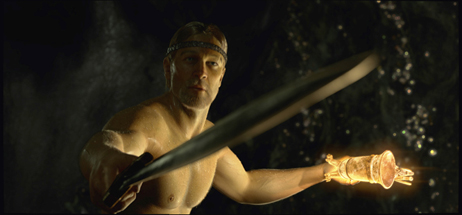|
|
Movie Review: BeowulfBy Matthew HuntleyNovember 29, 2007
With that said, Beowulf works as fantasy action, with some amazing visuals and heavy characters. This is Zemeckis' third venture into motion capture after The Polar Express and Monster House, the former which he also directed. Zemeckis' intention with Beowulf, I think, is to express how the titular hero's larger-than-life mysticism and abilities go beyond human. I think Zemeckis wants us to be aware we're watching animation, and not accept it as reality. After all, what would be the point? The very nature of fantasy and mythology is to displace us from the world in order to explain things about it. It's not to adhere to the laws of nature. During its short existence, I have enjoyed motion capture films but still find a problem with how the technology renders characters' eyes. Unlike 2-D or computer animation, the animators try hard to make the characters' eyes look human, with realistic colors and sizes. But somehow, they still end up looking cross-eyed as if the characters are wearing masks. And because it's a character's eyes we first notice, that lack of depth gives way to an absence of soul. This is where filming humans would have worked better. But that doesn't dismiss the movie's other virtues. Set in 700 A.D., King Hrothgar (Anthony Hopkins) drunkenly celebrates his ruling over Heorot, a cold and rustic kingdom in a mountainous region of Denmark. One night, the monster Grendel (Crispin Glover), awakened and disturbed by Heorot's singing and merriment, attacks and kills several people in the mead hall. Unable to attack Hrothgar, Grendel retreats to his mother (Angelina Jolie).
|

|
|
|

|
Thursday, October 31, 2024
© 2024 Box Office Prophets, a division of One Of Us, Inc.


